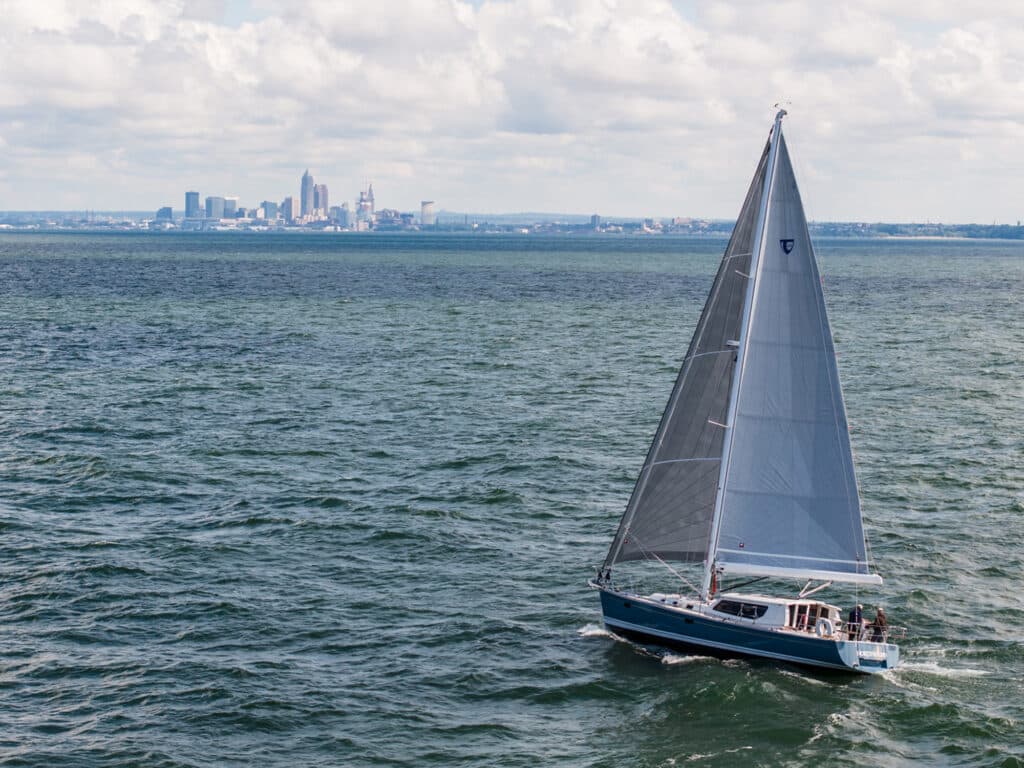
For me, for many reasons, certain boats and brands are synonymous with the waters or regions where they were created. The places are an essential component of the boats’ DNA. I’ll always associate a varnished mahogany runabout with upstate New York, or a cool little vintage catboat with Buzzards Bay and southern New England. Every classic Hinckley or Morris that I come across paints a vivid portrait of coastal Maine. Even yachts that sail or cruise far and wide all over the world still convey a sense of place. Recently, aboard a new Tartan 455, we pointed the bow into choppy Lake Erie, and I intuited an instant connection to the nearby northeast Ohio plant where the boat was spawned. It all felt like home.
Other people see different things. After I uploaded a photo to social media of myself steering the 455, an old pal quickly hit me back with a comment, asking: “Tartan is still building boats?”
The answer is an emphatic yes, and pretty darn good ones at that. The company has certainly had its ups and downs over the years, but it’s now navigating smoother waters for a couple of major reasons. First, it was recently acquired by Seattle Yachts, which made significant investments in the product and facilities, and appears firmly committed for the long haul. Second, longtime Tartan designer Tim Jackett is running operations, and the native Ohio homeboy is giving it his all.
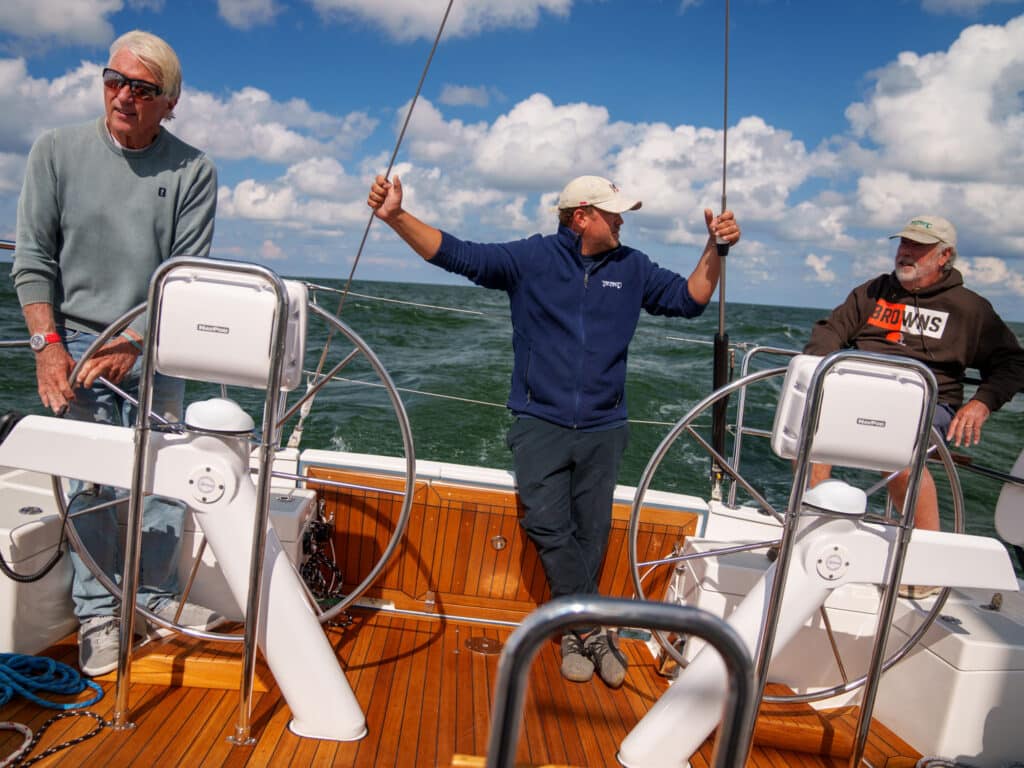
Jackett says the 455 evolved from powerboats by Legacy, a company Tartan acquired in 2010. “The roots of it came after having some exposure to the Legacy brand and looking at how the deck and interior of that sedan style of powerboat works out so nicely,” he says. His first swing at the design in sailboat mode was a 37-foot motorsailer with a substantial trim tab that powered up at 14 knots. (It was never built.) When the owner of a Tartan 3700 approached him about commissioning a larger boat, Jackett returned to expand upon his earlier incarnation.
“But the concept was the same,” he says. “More of a sailing hull, but a nice, big, well-lit living space with inside steering, and then an aft cockpit that gave you the normal sailing experience of wind and water in your face when you wanted it.”
Down a few steps into the deep cockpit, sliding doors open into the salon, which transitions into the forward living areas. The bulletproof laminate is a vacuum-bagged, infused sandwich that employs epoxy resin with a foam core in the hull construction and end-grain balsa in the deck. The lead keel supports a hefty ballast bulb and is available in deep- and shallow-draft configurations.
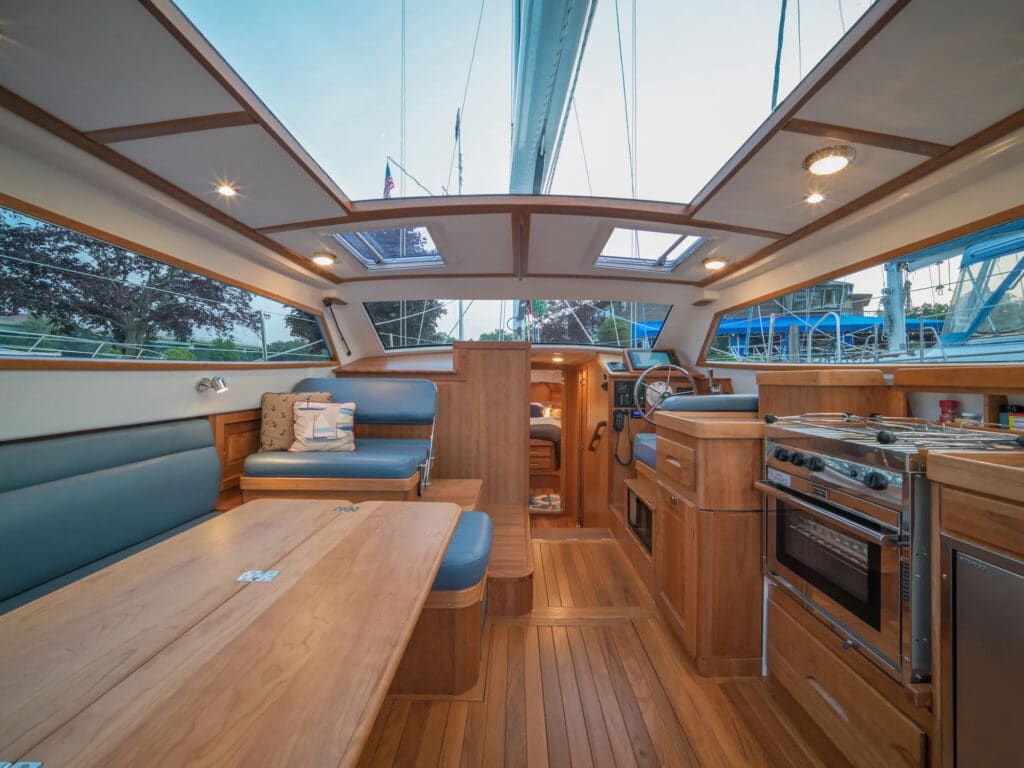
There are a couple of accommodations plans, including a two-stateroom version or the three-stateroom layout employed in the model we sailed, with guest staterooms to port and starboard, and an owner’s space forward with an attached head. The well-executed joiner work and furniture were cherry, though teak and maple are available (much of it sourced from northeast Ohio’s Amish mills). I’d say this is primarily a comfortable couple’s boat with space for occasional visits from family and friends.
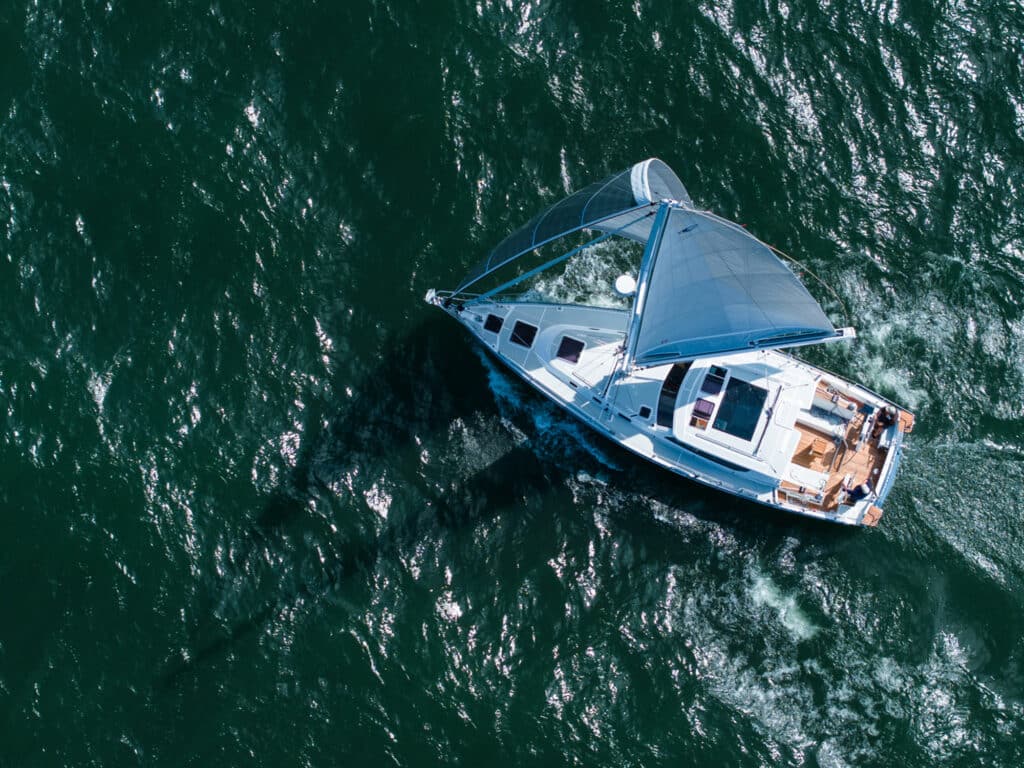
Aesthetically, I found the lines plan of the 455 to be handsome and pleasing, not a particularly easy task with a large deckhouse, which Jackett incorporated nicely into the profile.
Wraparound windows allow light to pour in from all directions, as does the deckhouse’s overhead window. A split hydraulic backstay provides easy access to the drop-down transom and boarding platform between the twin wheels, which are stationed well outboard. (There’s a single, deep spade rudder.) Moving forward, an outboard ramp rises from the cockpit to the side decks, which makes for easy egress to the topside and foredeck. I believe this feature originated with the Jeanneau line, and I always thought it was a trend that would spill over to other builders (see the Moody 41DS). It’s just too simple and elegant a solution to an age-old design conundrum. There are grippy stainless-steel handrails just about everywhere. This Tartan is a big boat but an easy one to negotiate.
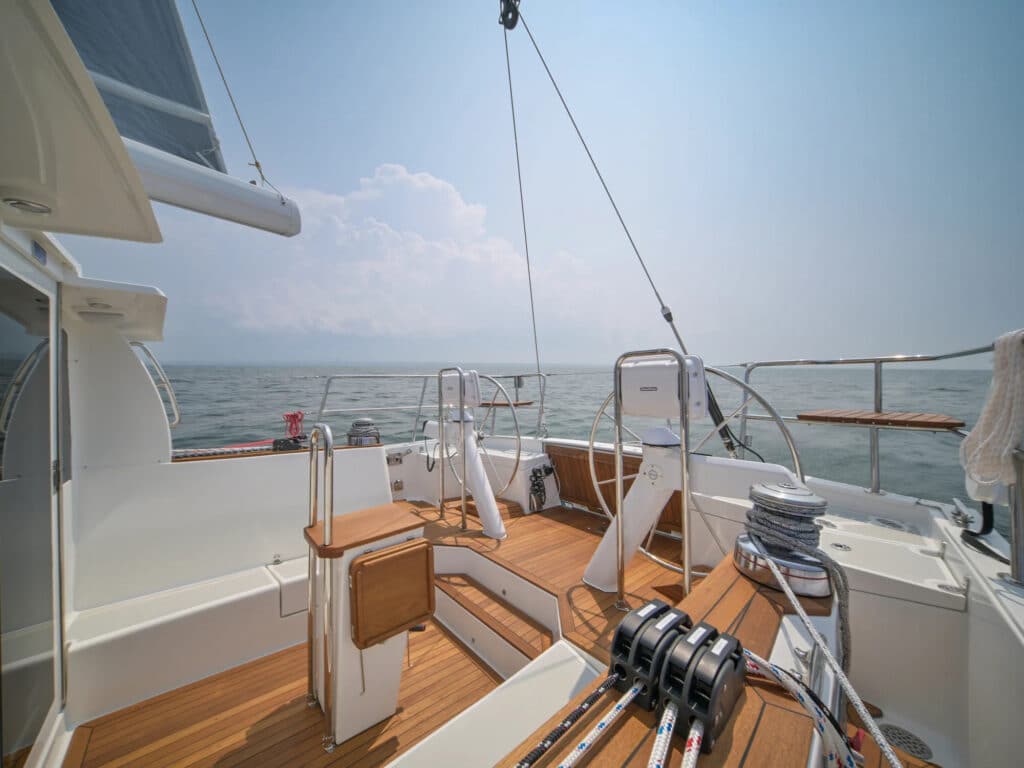
The carbon-fiber, double-spreader rig is fashioned in Tartan’s in-house autoclave, as are the rudder post and other reinforcements. The company’s Cruise Control Rig double-headsail sail plan (also known as a Solent setup) has become a fixture across the brand, with a Code Zero-style reacher on the forward stay and a smaller, self-tacking jib on the aft one. The powerful, full-battened mainsail is stashed in a Leisure Furl in-boom furler, and there’s a wide traveler atop the deckhouse that facilitates the end-boom mainsail sheeting. All the running rigging is led into the cockpit and handled by a combination of rope, clutches and Harken electric winches. The excellent sails come from Sobstad’s loft in nearby Rocky Hill.
Over the years, I’ve sailed many a Jackett design, and the common denominator is they sail exceedingly well. We sailed the 455 on an early-fall afternoon after a cold front rolled through, offering up ideal 10- to 15-knot northwest breezes. The waves in the relatively shallow lake were closely spaced. As I took the wheel and came onto the wind under the smaller jib, it took me a while to stop pinching and get in the groove. But once I fell off a good 10 degrees, the boat and I settled in, and it muscled through the chop with aplomb.
The steering was tight and accurate. Jackett says he was still playing with the optimal rudder configuration, but it all felt fine to me. Topside, the Jefa wheels are cable-controlled, while the deckhouse steering station is on a hydraulic ram. You toggle between the two, depending on where you’re driving. We swapped out the self-tacker for the large reacher and bore off another 10 degrees, and the boat absolutely lit up, trucking along on a beam reach at bursts over 9 knots in complete and utter control. We even jibed the big sail through the exceedingly tight foretriangle, a maneuver I wouldn’t have thought possible. It was quite the sail.
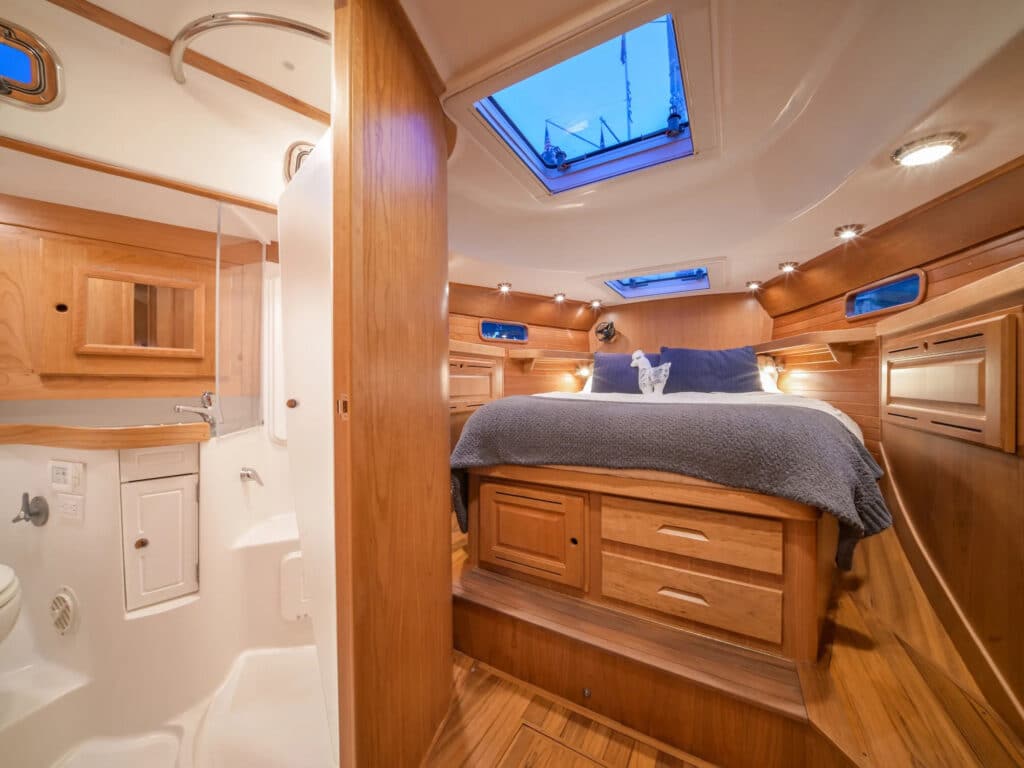
Fittingly, the first Tartan 455 is going to live on the Great Lakes, with Lake Huron’s North Channel a likely regular cruising ground. But I can envision this to be a terrific yacht for the Pacific Northwest and beyond, and ideal for high-latitude adventures. You might not be able to take the Ohio out of a Tartan, but you can take this Tartan just about anywhere.
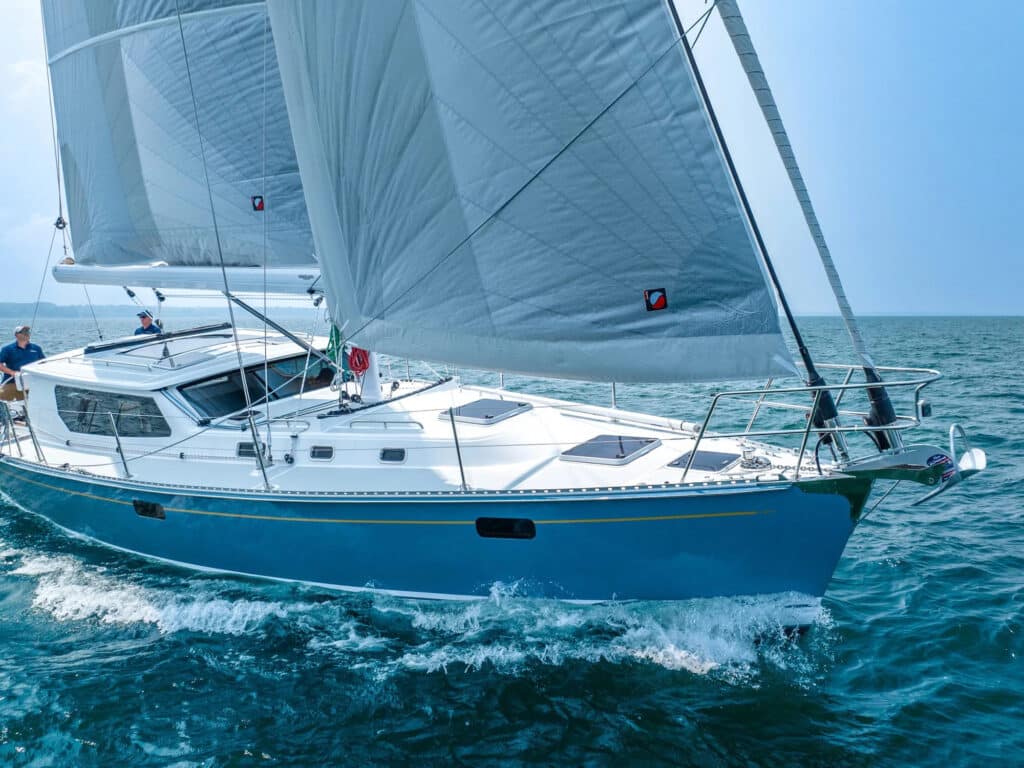
Tartan 455 SPECIFICATIONS
| LOA | 45’6” |
| BEAM | 14’1” |
| DRAFT | 6’6” |
| SAIL AREA | 978 sq. ft. |
| DISPLACEMENT | 25,750 lb. |
| D/L | 132 |
| SA/D | 17.1 |
| WATER | 200 gal. |
| FUEL | 140 gal. |
| MAST HEIGHT | 64’3” |
| ENGINE | 75 hp diesel w/ sail drive |
| DESIGN | Tim Jackett |
| PRICE | $899,000 (base) |
| WEBSITE | tartanyachts.com |
Herb McCormick is a CW editor-at-large.








